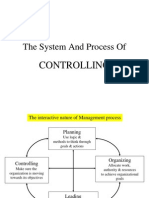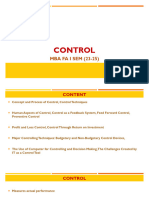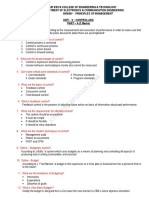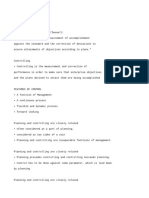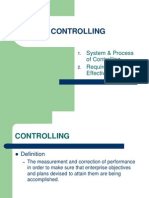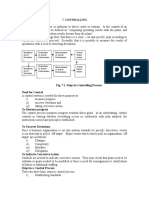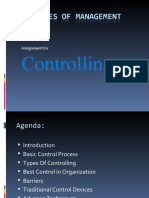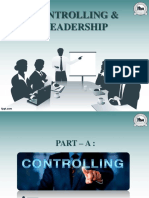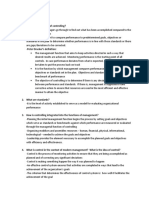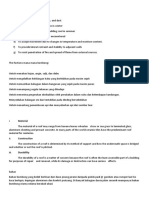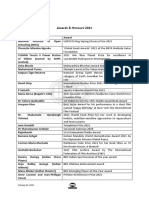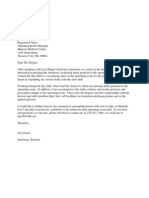Unit – 5 Controlling Strategies
System and Process of Controlling
Controlling
The measurement and correction of performance in order to make
sure that enterprise objectives and the plans devised to attain them
are being accomplished
Without objectives and plans, control is not possible because
performance has to be measured against some established criteria
The Basic Control Process
Establishing standards
Measuring performance against these standards
Correcting variations from standards and plans
2
�The Basic Control Process
Establishment of Standards
Standards – Criteria of performance
Selected points in an entire planning program at which measures of
performance are made so that managers can receive signals about
how things are going and thus do not have to watch every step in the
execution of plans
Measurement of Performance
Measurement be done on a forward – looking basis so that deviations
may be detected in advance of their occurrence and avoided by
appropriate actions
Correction of Deviation
By exercising their organizing function through reassignment or
clarification of duties
3
�Critical Control Points, Standards, and
Benchmarking
Principle of Critical Point Control
Effective control requires attention to factors critical to evaluating
performance against plans
Types of Critical Point Standards
Standards are physical, cost, capital, revenue, program, intangible, goal,
and strategic plans as control points for strategic control
Strategic Control
Systematic monitoring at strategic control points and modifying the
organization’s strategy based on this evaluation
Benchmarking
An approach for setting goals and productivity based on best industry
practices
Three types – Strategic, Operational, and Management
4
�5
�Control as a Feedback System
Control as Feedback
Many systems control themselves through information feedback,
which shows deviations from standards and initiates changes
Management control is usually perceived as a feedback system similar
to the common house – hold thermostat
Real Time Information and Control
Advances arising from the use of the computer and from electronic
gathering, transmission, and storage of data is the development of real
time information
Information about what is happening while it is happening
Real – time control in areas of importance to managers
6
�Feed forward or Preventive Control
Feed forward Systems
Monitor inputs into a process to ascertain if the inputs are as planned;
if they are not, the inputs or the process is changed in order to obtain
the desired results
Requirements for Feed forward Control
Identify the more important input variables
Develop a model of the system
Take care to keep the model up to date
Collect data on input variables regularly, and put them into the system
Regularly assess variations of actual input data from planned – for
inputs, and evaluate the impact on the expected end result
Take action to solve them
7
�Comparison of Simple Feedback & Feed forward Systems
8
�Control of Overall Performance
Reasons for control of overall performance
Overall planning must apply to enterprise, so must overall
control
Decentralization of authority
Overall control permits the measurement of an integrated
area manager’s total effort, rather than parts of it
Many overall controls in business are financial
9
�Other Controls
Profit and Loss Statement
Shows all revenues and expenses for a given time, so it is a true
summary of the results of business operations
Limitations – Duplication of accounting records, allocating overhead
costs, and time etc.,
Control through Return on Investment
Measures both the absolute and the relative success of a company or
company unit by the ratio of earnings to investment of capital
Bureaucratic and Clan Control
Bureaucratic – Characterized by the wide use of rules, regulations,
policies, procedures, and formal authority
Clan – Based on norms, shared values, expected behavior, and other
cultural variables
10
�Requirements of Effective Controls
Tailoring Controls to Plans and Positions
Reflect the organization structure, showing who is responsible for the
execution of plans and for any deviation from them and should be
tailored to positions
Tailoring Controls to Individual Managers
Individual Managers carry out their function of control
Designing Controls to Point up Exceptions at Critical
Points
Efficient control requires that managers look for exceptions, while
effective control requires that managers pay primary attention to
things that are most important
Seeking Objectivity of Controls
Manager’s or a Subordinate’s personality may influence judgments of
performance and make them less accurate
11
�Requirements of Effective Controls contd….
Ensuring Flexibility of Controls
If controls are to remain effective despite failure or unexpected
changes of plans, they must be flexible
Fitting the Control System to the Organizational Culture
Generalized and permissive control system will hardly succeed
Achieving Economy of Controls
Controls must be worth their costs
Establishing Controls that Lead to Corrective Action
An adequate control system will disclose where failures are occurring
and who is responsible for them, as well as ensuring that corrective
action is taken
12
�The Budget as a Control Device
Budgeting
The formulation of plans for a given future period in numerical terms
Financial terms – as in revenue and expense as well as capital budgets
Non-Financial terms – as in budgets of direct – labor – hours,
materials, physical sales volume etc.,
Dangers in Budgeting
Unwise decisions to meet the budget
Not invest in R & D, Capital investment for productivity etc.,
Zero – Base Budgeting
Dividing enterprise programs into packages composed of goals,
activities, and needed resources and calculating the costs for each
package from zero
Advantage – it forces managers to plan each program package afresh
13
�Time – Event Network Analyses
Techniques designed to assess how the parts of a program fit
together during the passage of time and events
Gantt Charts
A bar chart that shows the time relationships between the “events” of
a production program
Total program goals – regarded as interrelated supporting plans
Picking out the more critical elements of a plan to watch carefully
Milestone Budgeting
Identifiable segments
Break a project down into controllable pieces and then carefully
follow them
14
�Time – Event Network Analyses contd….
Program Evaluation and Review Technique (PERT)
A time – event network analysis system in which the various events in
a program or project are identified, with a planned time established
for each
Relationships of each event to the other events
Event – a supporting plan whose completion can be measured at a
given time
Activity time – time required to accomplish an event
Critical Path – Sequence of events that takes the longest time and that
has zero (or the least) slack time
Identifying it at the start makes possible close monitoring of this
particular sequence of events to ensure that the whole program is on
schedule
15
�Strength and Weaknesses of PERT
Strengths
It forces managers to plan and how the pieces fit together
Subordinate manager must plan the event for which he or she is
responsible
It concentrates attention on critical elements that may need
correction
Makes possible a kind of forward – looking control
Able to take action at the right spot and at right time
Weaknesses
Not useful when a program is no reasonable
Two or more groups of people to work on an event when costs
permit
Time only, not on costs
16
�Information Technology
Management Information System
A formal system of gathering, processing, and dispersing information
internal and external to the enterprise in a timely, effective, and efficient
manner to support managers in their jobs
Communication and the Management Information System (MIS) are the
linkage that makes managing possible
Expansion of Basic data
Managers need all kinds of nonaccounting information about the external
and internal operations
Information should be qualitative as well as quantitative
Information Indigestion and Intelligence Services
Information overload is solved by the development of intelligence experts
Managing by the numbers
Attempts are made to model workers in large organizations by using
concepts such as “numerati”
The idea is to build mathematical models of people in a large organization
17
�Use of Computers in Handling Information
Impact
Computer – aided communication impacts not only on decision making
but also on organizational design
The impact of computers on managers at different
organizational levels
Supervisory level – Scheduling, daily planning, and controlling of the
operation are just a few uses
Middle – Level – Responsible for administration and coordination
Top – Level – Responsible for strategy and overall policy of the
organization
The Application and Impacts of Microcomputers
Flexible, Inexpensive and used more quickly
Applications – Spreadsheets, budget preparation etc.,
The Twitter Phenomena
Free social networking service with an author who has followers
18
�Opportunities and Challenges Created by IT
Challenges
Resistance to computer use
Speech recognition devices
Telecommuting
Working at a computer terminal at home instead of commuting to work
Computer Networks
The internet – Network of computers and network of networks
Other type of networks
Groupware – Software that enables a group of people on a network to
collaborate over long distances at the same time
Freeware – usually pertains to a fully functional software with no cost to
the user
Information Security
19
�Productivity
Definition
The output – input ratio within a time period with due consideration
of quality
Implies measurement
Quality Measurement in Information age is Wal – Mart
Productivity Problems
Greater proportion of less – skilled workers with respect to the total
labor force
Emphasis on immediate result
Workers’ attitudes, and government policies and regulations
Productivity dilemma is the growing affluence of people, which makes
them less ambitious
20
�Measurement of Productivity
Skill Workers
Person on a production line
Bricklayers, mechanics, and butchers
Measurement is easy
Knowledge workers
Assistant to the manager with planning as his or her main function
Managers, engineers, and programmers
Difficult – quality of outputs is often hard to measure
21
�Production and Operations Management
Production Management
Deals with activities necessary to manufacture products
Expanded as purchasing, warehousing, transportation, and other
operations until a product is available to the buyer
Operations Management
Deals with activities necessary to produce and deliver a service as
well as a physical product
Do not produce a physical output but provide some service as an
output
Service providers are hospitals, doctors, consultant, airlines,
restaurants, musicians and the great variety of retail stores
22
�23
�Tools and Techniques for Improving Productivity
Many tools and techniques available for improving
manufacturing and service operations
Inventory Planning and control
Just – in time inventory system
Outsourcing
Operations research
Value engineering
Work simplification
Quality circles
Total quality management
Lean manufacturing
CAD & CAM
24
�Tools & Techniques for Improving Productivity Contd...
Inventory Planning and Control
25
�Tools & Techniques for Improving Productivity Contd...
Just – in – Time Inventory (JIT) System
The supplier delivers the components and parts to the production
line only when needed and “just in time” to be assembled
Zero inventory and Stockless production (other names)
Outsourcing
The contracting of production and operations to outside vendors that
have expertise in specific areas
Tool for expanding a company and for maintaining a competitive
position
Operations Research
The application of scientific methods to the study of alternatives in a
problem situation, with a view to obtaining a quantitative basis for
arriving at a best solution
26
�Tools & Techniques for Improving Productivity Contd...
Value Engineering
The process of analyzing the operations of the product or service,
estimating the value of each operation, and attempting to improve
that operation by trying to keep costs low at each step or part
Work Simplification
The process of obtaining workers’ participation in simplifying their
work
Training sessions are conducted to teach concepts and principles of
techniques such as time and motion studies, work – flow analyses, and
the layout of the work situation
Quality Circles
A group of people from the same organizational area who meet
regularly to solve problems they experience at work
27
�Tools & Techniques for Improving Productivity Contd...
Total Quality Management
Long – term commitment to continuous quality improvement,
throughout the organization and with the active participation of all
members at all levels, to meet and exceed customer expectations
Lean Manufacturing
Continuous improvements with strategic breakthroughs
Aiming at zero defects
Responsibility for problems rests on everyone, especially management
Computer – aided Techniques
Capturing the market quickly is crucial in the very competitive
environment
Firms can respond more rapidly to the requests of customers with
specific requirements
28
�Supply Chain & Value Chain Management
Supply Chain Management
SCM – Focuses on the sequence of getting raw materials and
subassemblies through the manufacturing process economically
Focuses more on the internal process with an emphasis on efficient
flow of resources, such as materials
Value Chain Management
VCM – Involves analyzing every step in the process, ranging from the
handling of raw materials to servicing end users, providing them with
the greatest value at the lowest cost
Similar with an additional concern for the external environment, such
as the customer
29
�Reporting
Budget Summaries and Reports
Resume of the particular company – Sales volume, profit, credit, cost,
purchase and Return on Investment
Purpose of Budgets and Reports
Budget summaries and reports are the major tools for top
managements to find out where the deviation has occurred
Return on Investment (ROI)
Broadcast measure of overall performance of a business
Obtain satisfactory return on capital invested
To measure efficiency
30
�Advantages and Limitations of ROI
Advantages
Shows business efficiency
Vital role in decision making
Interdepartmental comparison
To make effective changes in financial policies
Limitations
Inventory valuation and depreciation cannot be measured
Not the correct judgment of financial analysis
High rate of ROI, the managers may not be interested in the business
activities due to the fear of decrease in ROI
31
�International Management
Definition
Focuses on the operation of international firms in host countries
Flow of people, goods, and money, with the ultimate aim of managing
better in situations that involve crossing national boundaries
Environmental factors differ from domestic firms
Interact with employees who have different educational and cultural
background and value systems
Nature and Purpose of International Business
Engage in transactions across national boundaries
Joint venture is strategic alliance that is often formed in order to
expand geographically, or to expand the market for products or
services
Contact between parent firm and host country is affected by several
factors, some are unifying, while others can cause conflicts
32
�33
�34
�International Management: Cultural and
Country Differences
35
�Factors
Unifying effects
Parent company assists the local company in the development of
human and material resources
Both partners are integrated into a global organizational structure
with equity and long lasting relationship
Potentials for conflict
Nationalistic self – interest
Socio – cultural differences
Overpowering economic on a small host company
Some international corporations have been charged with making
excessive profits
Hiring the best local peoples and so on
36
�Multinational Corporations (MNCs)
Definition
Have their headquarters in one country but operate in many
countries
From ethnocentric to geocentric orientation
Ethno – centric orientation
The style of the foreign operations is based on that of the parent
company
Poly – centric orientation
The foreign subsidiaries are given a great deal of managerial freedom
Regio – centric orientation
The foreign operations are staffed on a regional basis
Geo – centric orientation
The entire organization is viewed as an independent system operating
in many countries
37
�Multinational Corporations (MNCs) contd…
Advantages of multinationals
Raise money for its operations throughout the world
Products can be produced most cost – effectively and efficiently
Better access to natural resources and materials
Recruiting personnel from a worldwide labor pool
Challenges for multinationals
Increasing nationalism
Lack in managerial, marketing, and technical skills
Maintaining relationships between the parent and host
Aware of the value of their natural resources
38
�Globalization and Liberalization
Globalization
View the whole world as one market
Corporation also has to adapt to national and even local needs
For example: Developing a drug delivery system
Liberalization
It eliminates licensing quantitative restrictions and other regulatory
and discretionary controls
To accelerate the growth rate of industrial sector and to achieve
export promotion on a large scale
Gives an enormous boost to private investment in the industrial
sector
39
�Global Theory of Management
Theories
Situational and Contingency approaches
Motivation and Leadership theory
Organization behavior
Technology
Privatization
Liberation approach
Globalization of Business
Japanese Management
Characteristics – HR, Job Security, Team work, Promotion, Appraisal
system, Communication, and Decision Making
40
